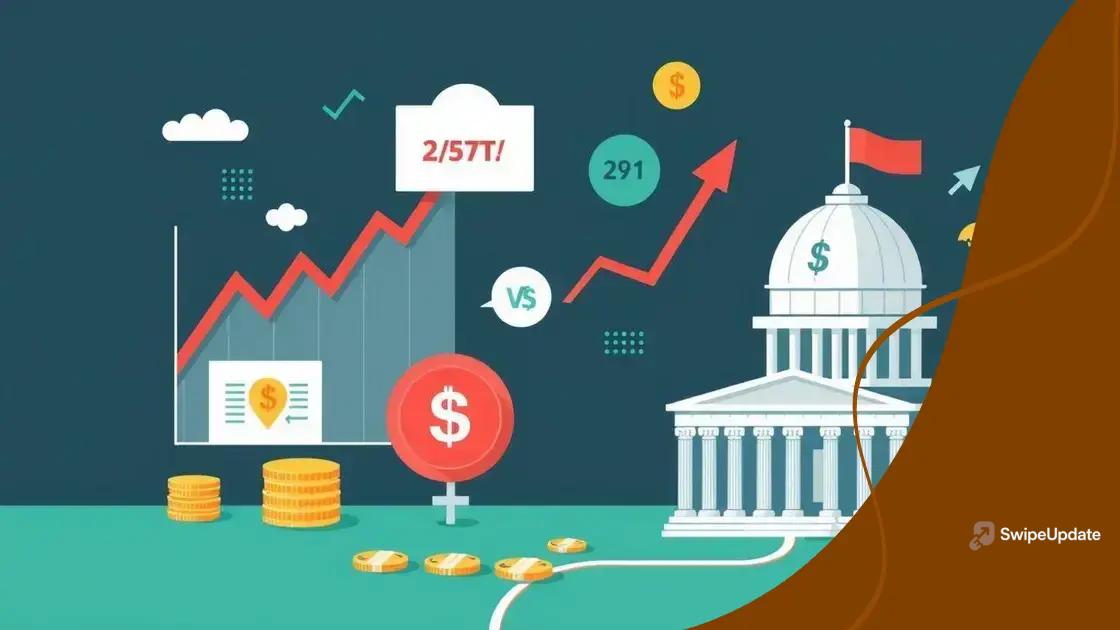The ongoing discussion about the national debt: what you need to know

The national debt refers to the total amount of money that a government owes its creditors, and can be managed effectively through strategies like reducing spending, tax reforms, and promoting economic growth.
The ongoing discussion about the national debt raises many questions that are crucial for all of us. How does it affect our daily lives and the economy? Understanding this topic can help us navigate our finances better.
Understanding the national debt
Understanding the national debt is essential for grasping how a country’s economy functions. It involves the total amount of money that a government owes its creditors. This debt can have significant implications for future generations, impacting everything from taxes to public services.
What is National Debt?
The national debt consists of two main components: public debt and intragovernmental holdings. Public debt is the money borrowed from external sources, such as individuals and foreign governments. Intragovernmental holdings refer to the money owed by the government to itself, often through trust funds like Social Security.
Key Reasons for National Debt
- Budget deficits occur when government spending exceeds revenue.
- Wars or military interventions can lead to increased borrowing.
- Economic downturns often result in lower tax revenues and higher spending on social programs.
- Infrastructure projects can require borrowing for funding.
The consequences of high national debt are also critical to understand. For instance, it can lead to higher interest rates, as the government competes with the private sector for borrowing. Moreover, a rising national debt may affect government spending priorities, as more funds are allocated to interest payments rather than essential services.
It’s important to consider the impacts of national debt on everyday citizens. For instance, increased debt can lead to greater taxes in the future to pay off this debt. Furthermore, if the debt grows too large, it can threaten a country’s financial stability, affecting not just the government, but individuals, businesses, and the economy as a whole.
In addition, public awareness about national debt is growing. Citizens are becoming more concerned about how it impacts their future. Discussions in the media and among politicians highlight the need for fiscal responsibility. As we become more informed about the risks and benefits of national debt, we can advocate for policies that support a healthier economy.
Key factors influencing national debt
Key factors influencing the national debt are crucial to understand how economic policies shape a nation’s financial landscape. Different elements contribute to rising debt, and acknowledging these can help in grasping the complexity of governmental finance.
Economic Growth Rates
One of the primary factors is the economic growth rate. When the economy expands, revenues from taxes typically increase, helping to reduce debt. Conversely, during economic downturns, revenues fall, and the government may borrow more to stimulate growth.
Government Spending
Government spending is another critical aspect. When spending exceeds revenue, it leads to budget deficits. This deficit is often financed through borrowing, contributing to the national debt. Key areas of spending include:
- Healthcare programs like Medicare and Medicaid.
- Social Security benefits.
- Defense and military expenditures.
- Infrastructure development projects.
Understanding these spending categories can illuminate why debt levels rise, especially if the funding does not yield economic growth. Additionally, unexpected expenses, such as those arising from natural disasters or pandemics, can further increase the debt.
Another factor is interest rates. When interest rates are low, the cost of borrowing decreases. This leads to higher levels of debt, as governments are incentivized to borrow more. However, if interest rates rise, the cost of servicing that debt increases, putting pressure on the budget.
Political decisions also heavily influence national debt. Policies related to taxation, welfare, and military engagement are regularly debated. Choices made by legislators regarding these issues can lead to significant changes in debt levels. For example, tax cuts may boost short-term economic activity but can increase long-term debt if not accompanied by spending cuts.
The impact of national debt on the economy

The impact of national debt on the economy is profound and multi-faceted. As the national debt rises, it can influence various economic factors, affecting both government policies and individual citizens’ lives. Understanding these effects is crucial for informed discussions about economic health.
Interest Rates and Borrowing Costs
One significant impact of national debt is its effect on interest rates. When the government borrows heavily, it competes for funds in the financial markets. This competition can lead to increased interest rates, making it more expensive for businesses and individuals to borrow. Higher borrowing costs can slow economic growth, as less money is available for investment in new projects.
Inflationary Pressures
Another potential impact is on inflation. If the national debt grows too large, the government may resort to printing more money to service that debt. This increase in money supply can lead to inflation, where the prices of goods and services rise. Inflation erodes the purchasing power of money, making it more challenging for families to manage their budgets.
Government Spending Priorities
The national debt can also shift government spending priorities. As more money goes toward paying interest on the debt, less is available for essential services like education, healthcare, and infrastructure. This can lead to long-term challenges in these critical areas as funding becomes constrained.
- Reduced investment in public services and infrastructure.
- Increased taxes for future generations to cover repayment costs.
- Potential cuts to social programs that support vulnerable populations.
Moreover, rising national debt can create uncertainty in the economy. Investors may lose confidence if they believe that the debt is becoming unsustainable, which can lead to economic instability. This instability can affect everything from stock market performance to consumer spending habits.
In summary, the impact of national debt on the economy is complex. It touches on interest rates, inflation, government spending, and overall economic stability. Understanding these relationships is essential for grasping the broader economic picture and for making informed decisions as citizens and consumers.
Common misconceptions about national debt
Common misconceptions about national debt can lead to misunderstandings about its implications and management. Many people believe that national debt is entirely negative, but this view oversimplifies a complex issue.
Debt Equals Bankruptcy
One widespread misconception is that national debt leads to bankruptcy. Unlike individuals and businesses, governments can issue currency and have the ability to repay their debts in their own currency. Therefore, the idea that a country can go bankrupt in the same way a company can is misleading. This unique capacity allows governments to manage debts more flexibly.
All Debt is Bad
Another myth is that all debt is inherently bad. In reality, national debt can be a useful tool for funding essential programs and services. For instance, during times of economic decline, borrowing can provide necessary funds to stimulate growth through infrastructure projects and social programs. Properly managed debt can support economic stability and growth.
Higher Debt Always Leads to Increased Taxes
Many believe that national debt automatically results in higher taxes. While this can happen, it is not guaranteed. Governments have various ways to manage debt without increasing taxes, such as optimizing spending or improving economic growth, which can lead to higher tax revenues without raising tax rates.
- Countries can refinance existing debt at lower interest rates.
- Improving the economy can lead to increased tax revenue.
- Debt can be managed through cuts in non-essential spending.
Moreover, some people think that only future generations will bear the burden of the debt. However, current policies often affect how that debt is managed today. Decisions made by lawmakers now can lead to changes in funding priorities that impact the present.
In addition, misconceptions can lead to fear or panic about the national debt. Understanding the nuances can help citizens engage more constructively with the topic, promoting informed discussions that focus on solutions rather than alarm.
Strategies for addressing the national debt
Strategies for addressing the national debt are essential for ensuring long-term economic stability and growth. By understanding these strategies, governments can formulate effective policies to manage and reduce debt levels.
Reducing Government Spending
One of the primary strategies is to reduce government spending. By identifying areas where cuts can be made without harming essential services, the government can lower the deficit. Programs often reviewed for potential cuts include:
- Non-essential public services.
- Subsidies that do not directly impact economic growth.
- Administrative costs that can be streamlined.
Managing spending can help free up resources to address the national debt more effectively.
Increasing Revenue through Tax Reforms
Another approach is to increase revenue through tax reforms. By modifying tax codes, governments can enhance revenue without necessarily raising tax rates. Some ways to achieve this include:
- Closing tax loopholes that allow for tax evasion.
- Implementing fair taxation policies that ensure everyone pays their share.
- Encouraging economic growth through business incentives that eventually lead to increased tax revenues.
These reforms can create a more equitable tax system while also boosting government funds for debt reduction.
Promoting Economic Growth
Additionally, promoting economic growth is critical. A growing economy generates more tax revenue, allowing the government to address debt more effectively. Investing in areas like technology, education, and infrastructure can keep the economy expanding. When people have jobs, they pay taxes, which helps reduce the overall debt.
Implementing policies that support small businesses and innovation can also play a significant role. As these sectors grow, they contribute more to the economy and help increase overall national revenue.
Lastly, countries can consider refinancing their existing debt at lower interest rates. This strategy can reduce the burden of paying interest, allowing more funds to go directly to reducing the principal and addressing the debt.
FAQ – Frequently Asked Questions about National Debt
What is national debt?
National debt is the total amount of money that a government owes to its creditors, which can include both domestic and foreign lenders.
How does national debt affect the economy?
National debt can influence interest rates, government spending, and inflation, ultimately impacting economic growth and stability.
Can the national debt be managed effectively?
Yes, through strategies like reducing spending, implementing tax reforms, and promoting economic growth, governments can manage national debt sustainably.
What are common misconceptions about national debt?
Many believe that national debt always leads to bankruptcy or that all debt is bad; however, debt can be a tool for economic growth when managed properly.
